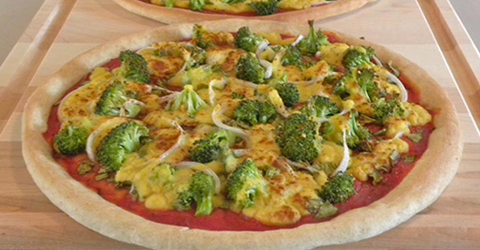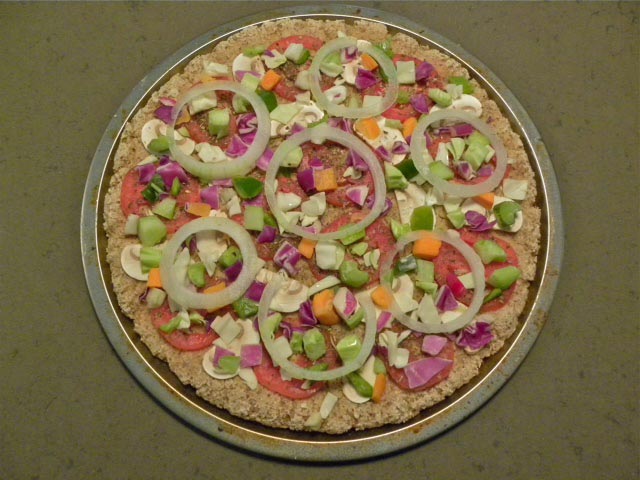

Is it possible to “think outside the pizza box” and to make a whole food, plant-based pizza at home that is truly healthy and yet satisfying in taste, texture, and nutritional content?
Yes! Making your own WFPB pizza is easy and fun to make, as well as inexpensive and nutritious.
In this article I’m going to show you how to make a delicious whole wheat & black beans pizza crust, give some suggestions for a fine tomato-based “bottom” sauce, mention a few possible toppings, and provide three easy-to-make “cheese-like” sauces from various whole grains, vegetables, nuts, and seeds. These sauces will “firm up” in texture when baked on top of a pizza and, depending upon the recipe selected, provide a custard to velvet-like “mouth feel.”
The easiest way to make your own pizza dough is by using a bread machine. Pre-made dough can be kept in a refrigerator for just under a week, and brought to room temperature when ready to make your pizza. However, one can always purchase plant-based pizza dough or a pre-made crust. Many local and major grocery stores have pre-made pizza dough available, and most pizza restaurants will even sell you their dough. Note that some doughs may have a little bit of salt and oil in them. Gluten-free pre-made crusts are also common.
Once you’ve shaped your dough into the pizza shape desired (circular, amoeba, rectangular — there is no required geometry!), press your shaped pizza into a non-stick pizza pan or cookie sheet (parchment paper works particularly well underneath), and then pre-heat your oven 425 to 450 degrees F. Some parchment papers will get brown over 425o F., and Reynold’s makes an aluminum foil that is “non-stick” on one side, maintains at 450o F., and also has the benefit of being easy to “mold” into different pans.
There are many fine pizza sauces available in grocery stores that are very low in fat and sodium. In a hurry? Spread tomato paste or sliced/diced/crushed tomatoes on a shaped pizza dough and sprinkle with garlic powder and/or Italian spices. Leftover chili works well, so does any kind of salsa! I can also recommend Trader Joe’s inexpensive no oil or salt pizza sauce.
Vegetables should be cut to mouth-size, while even tender greens such as kale or chard can be chopped up and used (I like putting a layer of chopped greens on the dough 1st, then adding sliced tomatoes, onions, mushrooms, and spices). Pressed for time? There are inexpensive, diced vegetable mixes available that you can sprinkle on top of your pizza sauce. Cooked legumes also make a great topping, adding more fiber and superb nutrition.

By using grains and beans, for example, a splendid no-fat “cheese-like” topping (or bottom!) sauce can be made that provides a delightful firmness when baked. Our goal is not to duplicate cheese, but instead, to provide a delectable alternative. Those sauces with beans tend to be “thicker” from the wonderful fiber they bring to the game.
Most cheese-like sauces can be made in a blender or food processor, although some will require pre-cooked grains and/or vegetables. Once the ingredients are prepared, the procedure is essentially the same in all cases:
These sauces can be originally warmed until slightly thickened in a sauce pot, then used in stir-fries, on baked potatoes, cooked grains or pasta (casserole!), as dips, dressings, and more. To use leftover sauce (which will keep for several days in the refrigerator), add a little bit of liquid of choice and mix.
Truly nutritious whole food, plant-based pizza is not an imagined fantasy. It is now a delightful and delicious reality. Enjoy!
Copyright 2024 Center for Nutrition Studies. All rights reserved.